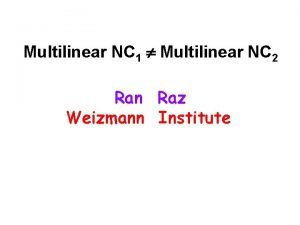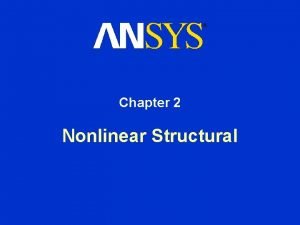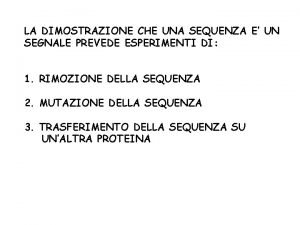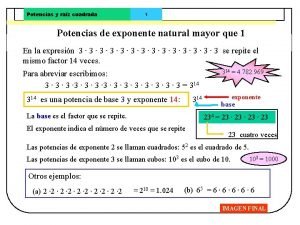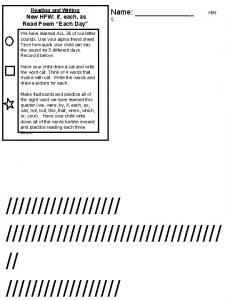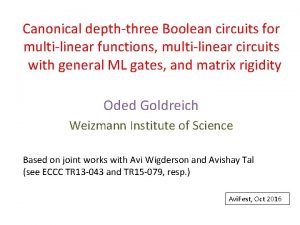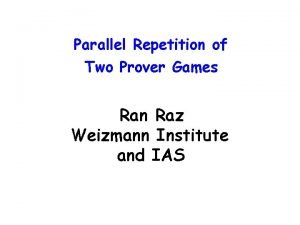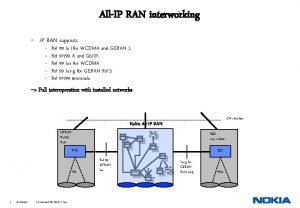Multilinear NC 1 Multilinear NC 2 Ran Raz



![Valiant Skyum Berkowitz Rackoff: Arithmetic NC 2 = Arithmetic P [H]: poly-size arithmetic circuit Valiant Skyum Berkowitz Rackoff: Arithmetic NC 2 = Arithmetic P [H]: poly-size arithmetic circuit](https://slidetodoc.com/presentation_image/b453fc6936f032d740d61d0e04129419/image-4.jpg)
![Multilinear Circuits: [NW]: Every gate in the circuit computes a multilinear polynomial Example: (X Multilinear Circuits: [NW]: Every gate in the circuit computes a multilinear polynomial Example: (X](https://slidetodoc.com/presentation_image/b453fc6936f032d740d61d0e04129419/image-5.jpg)

![Previous Work : [NW 95]: Lower bounds for a subclass of constant depth multilinear Previous Work : [NW 95]: Lower bounds for a subclass of constant depth multilinear](https://slidetodoc.com/presentation_image/b453fc6936f032d740d61d0e04129419/image-7.jpg)

![Partial Derivatives Matrix [Nis]: f = a multilinear polynomial over {y 1, . . Partial Derivatives Matrix [Nis]: f = a multilinear polynomial over {y 1, . .](https://slidetodoc.com/presentation_image/b453fc6936f032d740d61d0e04129419/image-9.jpg)
![Partial Derivatives Matrix [Nis]: f = a multilinear polynomial over {y 1, . . Partial Derivatives Matrix [Nis]: f = a multilinear polynomial over {y 1, . .](https://slidetodoc.com/presentation_image/b453fc6936f032d740d61d0e04129419/image-10.jpg)

![Partial Derivatives Method [N, NW] [Nis]: If f is computed by a noncommutative formula Partial Derivatives Method [N, NW] [Nis]: If f is computed by a noncommutative formula](https://slidetodoc.com/presentation_image/b453fc6936f032d740d61d0e04129419/image-12.jpg)







- Slides: 19

Multilinear NC 1 Multilinear NC 2 Ran Raz Weizmann Institute

Arithmetic Circuits (and Formulas): Field: F Variables: X 1, . . . , X n Gates: Every gate in the circuit computes a polynomial in F[X 1, . . . , X n] Example: (X 1 ¢ X 1) ¢ (X 2 + 1)

Classes of Arithmetic Circuits: NC 1: Size: poly(n) Degree: poly(n) Depth: O(log n) (poly-size formulas) NC 2: Size: poly(n) Degree: poly(n) Depth: O(log 2 n) P : Size: poly(n) Degree: poly(n)
![Valiant Skyum Berkowitz Rackoff Arithmetic NC 2 Arithmetic P H polysize arithmetic circuit Valiant Skyum Berkowitz Rackoff: Arithmetic NC 2 = Arithmetic P [H]: poly-size arithmetic circuit](https://slidetodoc.com/presentation_image/b453fc6936f032d740d61d0e04129419/image-4.jpg)
Valiant Skyum Berkowitz Rackoff: Arithmetic NC 2 = Arithmetic P [H]: poly-size arithmetic circuit ! quasipoly-size arithmetic formula Outstanding open problem: Arithmetic NC 1 Arithmetic NC 2 Are arithmetic formulas weaker than arithmetic circuits ?
![Multilinear Circuits NW Every gate in the circuit computes a multilinear polynomial Example X Multilinear Circuits: [NW]: Every gate in the circuit computes a multilinear polynomial Example: (X](https://slidetodoc.com/presentation_image/b453fc6936f032d740d61d0e04129419/image-5.jpg)
Multilinear Circuits: [NW]: Every gate in the circuit computes a multilinear polynomial Example: (X 1 ¢ X 2) + (X 2 ¢ X 3) (no high powers of variables)

Motivation: 1) For many functions, non-multilinear circuits are very counter-intuitive 2) For many functions, most (or all) known circuits are multilinear 3) Multilinear polynomials: interesting subclass of polynomials 4) Multilinear circuits: strong subclass of circuits (contains other classes) 5) Relations to quantum circuits [Aaronson]
![Previous Work NW 95 Lower bounds for a subclass of constant depth multilinear Previous Work : [NW 95]: Lower bounds for a subclass of constant depth multilinear](https://slidetodoc.com/presentation_image/b453fc6936f032d740d61d0e04129419/image-7.jpg)
Previous Work : [NW 95]: Lower bounds for a subclass of constant depth multilinear circuits [Nis, NW, RS]: Lower bounds for other subclasses of multilinear circuits [R 04]: Multilinear formulas for Determinant and Permanent are of size [Aar 04]: Lower bounds for multilinear formulas for other functions

Our Result: Explicit f(X 1, . . . , X n), with coeff. in {0, 1}, s. t. , over any field: 1) 9 poly-size NC 2 multilinear circuit for f 2) Any multilinear formula for f is of size multilinear NC 1 multilinear NC 2
![Partial Derivatives Matrix Nis f a multilinear polynomial over y 1 Partial Derivatives Matrix [Nis]: f = a multilinear polynomial over {y 1, . .](https://slidetodoc.com/presentation_image/b453fc6936f032d740d61d0e04129419/image-9.jpg)
Partial Derivatives Matrix [Nis]: f = a multilinear polynomial over {y 1, . . . , y m} [ {z 1, . . . , z m} P = set of multilinear monomials in m {y 1, . . . , y }. P| | = 2 m Q = set of multilinear monomials in m {z 1, . . . , z }. Q| | = 2 m
![Partial Derivatives Matrix Nis f a multilinear polynomial over y 1 Partial Derivatives Matrix [Nis]: f = a multilinear polynomial over {y 1, . .](https://slidetodoc.com/presentation_image/b453fc6936f032d740d61d0e04129419/image-10.jpg)
Partial Derivatives Matrix [Nis]: f = a multilinear polynomial over {y 1, . . . , y m} [ {z 1, . . . , z m} P = set of multilinear monomials in {y 1, . . . , y P| | = 2 m m}. Q = set of multilinear monomials in m {z 1, . . . , z }. Q| | = 2 m M = Mf = 2 m dimensional matrix: For every p 2 P, q 2 Q, Mf(p, q) = coefficient of pq in f

Example: f(y 1, y 2, z 1, z 2) = 1 + y 1 y 2 - y 1 z 1 z 2 Mf = 1 0 0 0 -1 y 1 0 0 y 2 1 0 0 0 y 1 y 2 1 z 2 0 z 1 z 2 1
![Partial Derivatives Method N NW Nis If f is computed by a noncommutative formula Partial Derivatives Method [N, NW] [Nis]: If f is computed by a noncommutative formula](https://slidetodoc.com/presentation_image/b453fc6936f032d740d61d0e04129419/image-12.jpg)
Partial Derivatives Method [N, NW] [Nis]: If f is computed by a noncommutative formula of size s then Rank(Mf) = poly(s) [NW, RS]: The same for other classes of formulas Is the same true for multilinear formulas ?

Counter Example: Mf is a permutation matrix Rank(Mf) = 2 m

We Prove: Partition (at random) {X 1, . . . , X 2 m } ! {y 1, . . . , y z m} m} [ {z 1, . . . , If f has poly-size multilinear formula, then (w. h. p. ): If for every partition Rank(Mf)=2 m then any multilinear formula forf is of super-poly-size ( )

High-Rank Polynomials: Define: f(X 1, . . , X 2 m ) is High-Rank if for every partition Rank(Mf)=2 m f is High-Rank ! any multilinear formula for f is of super-poly-size

Our Result: Step 1 Explicit f(X 1, . . , X 2 m ) over C, s. t. : 1) 9 poly-size NC 2 multilinear circuit for f 2) f is High-Rank (coefficients different than 0, 1) (We use algebraicly independent constants from C)

Our Result: Step 2 Explicit f(X 1, . . , X 2 m , X’ 1, . . , X’ r), with coeff. in {0, 1}, and r=poly(m), s. t. (over any field) 1) 9 poly-size NC 2 multilinear circuit for f 2) a 1, . . , a r algeb. independent ! f(X 1, . . , X 2 m , a 1, . . , a r) is High-Rank

Our Result: Step 3 If F is a finite field take. F ½ G of infinite transcendental dimension (G contains an infinite number of algeb. independent elements) Step 2 ! lower bound over G ! lower bound over F

The End
 Ran raz
Ran raz Ansys nonlinear analysis
Ansys nonlinear analysis Sequenza segnale
Sequenza segnale Lexema de subdesarrollado
Lexema de subdesarrollado Raz
Raz Sharon raz
Sharon raz Jeśli jesteś dziś szczęśliwy klaśnij raz
Jeśli jesteś dziś szczęśliwy klaśnij raz Raiz cuadrada de 36
Raiz cuadrada de 36 Noszenie talerzy chwyt dolny
Noszenie talerzy chwyt dolny Inbar raz
Inbar raz Interfijos
Interfijos Ancre amoco cadiz poids
Ancre amoco cadiz poids N prefijo
N prefijo Jeszcze raz
Jeszcze raz La raz
La raz Raz kids
Raz kids Raz kids
Raz kids Raz i dwa pewna pani miała psa
Raz i dwa pewna pani miała psa Partes de una raíz cuadrada
Partes de una raíz cuadrada O raz
O raz
